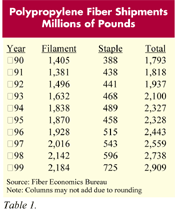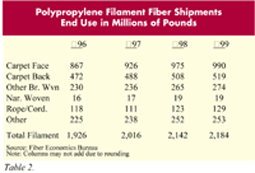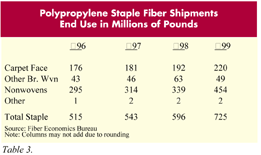Arguably, the growth fiber of the 1990s is polypropylene. Total production of polypropylene
filament, staple and film was 1.8 billion pounds in 1990 and rose at a compounded rate of 5.5
percent to the 2.9-billion-pound level in 1999, easily besting the 2.7-percent rate posted by its
nearest competitor, polyester fibers
(See Table 1).Filament fiber shipment growth through the 1990s averaged a compounded 5
percent per year while staple averaged 7.2 percent per year. To be sure, the U.S. fiber industry
ships more polyester than olefin, nearly 3.6 billion pounds for polyester filament and staple in
1999, but olefin wins the battle for growth rate hands down and is catching up fast in the total
shipment category.Faced with this growth despite a stagnant domestic market deluged by imports, it
becomes important to pose several related questions. First, is polypropylene technologically and
marketing-wise ready to move up into the class of 3-billion-pound fiber Second, are fiber suppliers
prepared to invest in fiber development to sustain/increase the current rate of growth And third,
are fiber producers prepared to adopt sufficiently creative marketing strategies to balance the
pressures expected from the combination of existing domestic competitors and importers In this
article, we first will review statistics to set the stage, and then reveal marketing and product
strategies planned or in execution by several major players in polypropylene distribution. These
activities are not all that is going on, but we suggest that they are admirable examples of
creative marketing and product strategic thinking found among polypropylene producers and
processors. Setting The StageA closer look at Table 1 suggests that growth in shipments of
total polypropylene fibers has slowed, a pattern consistent with maturing product lines. The data,
particularly in filament, hints that shipments to carpet end uses, representing almost two-thirds
of all filament shipments, gained a substantial boost in 1994 as spending on housing responded to
Federal Reserve-activated lower interest rates and recovered from the early-decade recession. This
was followed naturally by a slowing as current interest rate upticks exacted a toll on housing.
Since 1997, the rate of growth in filament has slowed dramatically, dropping to 2.0 percent from
1998 to 1999.Staple, however, appears to be enjoying a renewed rise, energized by an almost
one-third rise in staple use in nonwovens. In the 1990s, staple has received two positive
market-share shots, all driven by improving fortunes in nonwovens, which represent approximately
three-fifths of all polypropylene staple sales. First came the significant bump from the 1991-1992
recession recovery, followed by a significant jump from 1998 to 1999 as major diaper producers
displaced some film layers with fibrous (staple or spunbonded) layers to diapers to make the
product seem more fabric-like and consumer-friendly (Authors Note: Part of mid-decade growth
represents the Fiber Economics Bureau fine tuning its database to include both captive fiber and
spunbonded/meltblown fiber capacities, which historically had been under-reported).Filament
polypropylene in carpet face fibers, the main driver of filament polypropylene market share, grew a
mere 1.5 percent from 1998 to 1999 and filament in carpet-backing fabrics, a barely better 2.2
percent (See Table 2). Other broadwovens incorporating filament, including items like geotextiles
and upholstery, increased an average of 6 percent per year, compounded for the 1996-1999 period, to
retain a 12-percent share of filament shipments. Rope, cordage and fishline grew more slowly than
the category average and watched market share deteriorate slightly. Other filament end uses grew at
the category average of approximately 4 percent and thereby held their own in market share.The
largest end use in the Other category is an amalgam of spunbonded and meltblown filament products
for such markets as carpet backing, interliners, medical disposables, etc. Also included are much
smaller miscellaneous markets for such products as backing/structural materials for sliver knit
products, miscellaneous apparel items like thermal underwear, sport-specific athletic garments for
biking, aerobics, scuba diving, running and the like. Together, all the miscellaneous end uses do
not consume nearly the amount gobbled up by spunbonded and meltblown, but these smaller uses appear
to provide opportunities for new specialized products that can lead to increased market share and
value-added potential.Staple shipments in 1996 grew 12+ percent over 1995 (See Table 1). It must be
noted, however, that 1995 lagged behind 1994 by 6+ percent as all major end-use areas carpet face,
broadwoven (largely upholstery) and nonwovens sagged from record levels. Secondly, 1996 staple
shipments recovered from the 1995 lethargy to scale the 500-million-pound mountain for the first
time, regaining all and more of the 1995 losses (See Tables 1 and 3).This growth has continued to
the present, driven in large part by double-digit gains in carpet-face fiber shipments, coupled
with a mind-boggling 34-percent increase in nonwovens consumption in the 1998-1999 period (See
Table 3). All of this increase is not yet understood, although a significant portion represents
changes in diaper construction.As filament polypropylene is beholden to carpet distribution, so
also must its staple cousin answer to a demanding master, nonwovens. To date in this market,
polypropylene successfully has bested polyester staple, which in its day bested rayon and cotton.
The question now becomes, what can polypropylene staple suppliers do to retain market interest in
the product Is the current product satisfactory or is newness mandatory for continued growth Are
there more diaper construction changes on the horizon to re-energize polypropylene fibers again

Going ForwardIt is quite apparent from the foregoing analyses that polypropylene fibers
enjoy dominant positions in several large markets. It also appears that these markets are
commodity-focused and often subject to the rawest of price and cost competition actions. These
pressures already have forced current polypropylene technology into efficient manufacturing
postures to fend off inter- and intra-fiber competition and market-share grabs from imports.So far
the campaign is successful in both filament and staple, but some industry observers suggest that
practical machine production/efficiency limits are at hand and a new efficacy paradigm is required
to continue growth patterns. The industry has been effective in providing low-cost materials. Now
it must build new product and marketing strategies and become effective at those endeavors.

Marketing ChangesPolypropylene fibers are natural receptors for additives that bring
permanent market-specific characteristics to the material. Additives currently in use provide
anti-microbial, flame-retardant, higher heat resistance and higher strength characteristics to the
market. While these product innovation strategies find homes in a wide variety of end use markets,
it is important to note that new, innovative marketing strategies are an integral part of this
movement. The phrases solutions marketing and customer-focused are approaching hackneyed status,
but their impact is proving real in fiber marketing.Slimmed-down marketing organizations, created
by urgent needs for cost control or elimination, patrol customer plants looking for opportunities
to add value to existing businesses. For example, a two-year marketing initiative aimed at
improving carpet backing led Synthetic Industries, Chickamauga, Ga., to develop the secondary
backing, Softbac and the primary backing Patternloc. Both come from customer inputs, but this time
the customer was the installer, not the homeowner, who would be the ulitmate purchaser.Both
carpet-backing ideas came from installers. They save labor and material, making the overall cost to
the consumer lower than previous materials, despite a slight increase in per-square-yard expense
for the carpet because of the new technology.Polypropylenes environmental resistance and light
weight have long made the fiber a material of choice for geotextiles. As geotextiles have matured
into a science, fabric producers have adapted to and adopted specifications substantially more
detailed than predecessor materials demanded. Fiber development has played a small role in meeting
these new requirements. More importantly, however, has been the ongoing dialog with users and
installers that created an atmosphere of trust and gave fabric producers sufficient comfort to
justify the purchase of new processing equipment to meet the upgraded standards.Another example of
market-driven development comes from Coville Inc., Winston-Salem, N.C., which is creating fabrics
for scuba diving. Traditionally, divers like to leave the water and not remove their wet suits.
With traditional materials, this practice often results in rashes from microbe growth under a wet
suit. Coville decided to try using antimicrobial polypropylene in a line of diving fabrics. By
talking to divers, the company discovered that, particularly in warmer climes, diving garments dry
in the heat of the sun from the outside in. The challenge was to reverse this natural sequence by
creating a product that would dry from the inside out, thereby minimizing possible microbe growth
and promoting skin health. The answer lay in combining antimicrobial filament polypropylene with
spandex. The fabric is napped on the inside to create a warmth layer and brings with it the wicking
capacity of polypropylene plus a natural resistance to microbes granted by additive technology.
Individually, all the described technologies existed; it took diver input to group them into a
solution. Coville sells a premium fabric and develops opportunities to translate basic technology
into traditional bathing suit distribution. Fiber suppliers sell premium, performing yarns.

Technology DevelopmentsThe two cited marketing developments could not have worked
without advances in technology. Marketing is but one of the routes to added-value, niche markets.
Marketing has learned to work with development in an applied nature rather than as basic research.
Polypropylene producers are becoming increasingly adept at translating customer problems into
marketing opportunities incorporating marketing and technology advances.Lightweight filament yarns
are a small part of polypropylene distribution. Historically, the most successful filament olefin
markets have demanded heavy-denier fibers in the 200- to 1,000-denier range.Apparel has been the
holy grail for polypropylene marketers; polymer, fiber and fabric producers have searched for
apparel and home furnishings markets large enough to justify development of fine-denier products.
Until activewear developed around spandex in the late 1980s and early 1990s, polypropylene really
had little exposure in apparel.Following activewear, and development of antimicrobial polypropylene
additives, a natural marriage of two man-made fibers began to enjoy increased volume in the
traditional high-sweat markets of running, cycling and aerobics. Permanent color, wicking capacity
and antimicrobial advantages were wedded in a series of market-specific performance fabrics that
enjoyed vigorous growth among the Boomer and Gen X generation exercise fanatics.In addition to
diving and bathing suit materials, apparel fabric producers are modifying fabrics for running,
cycling and aerobics for a generation attempting to age gracefully, but still demanding hard bodies
and the visible trappings of success. Fabric developments continue apace to expand the fibers role
in activewear markets.Slow progress is being made in lightweight knitted and woven constructions
for apparel and home furnishings. Dyeable polypropylene has been the wish of fiber producers. It
currently is available in heavy deniers for woven rugs through KromaLon® polymer technology
developed by Equistar Chemical, Houston, but it is a long way from commercialization in fine
deniers for apparel and home furnishings. Considering the pressures from polyester and from
imported garments, we suspect that commercialization will continue to remain more a dream than a
reality. Fine denier, therefore, should continue to depend on marketing innovation and additive
technologies for growth.As might be inferred from the last paragraph, developments at the heavy end
of the polypropylene denier spectrum are much more active than those in fine deniers. For example,
the Clean Air Act and the Clean Water Act mandate levels of air and water cleanliness.
Polypropylenes low melting point often has prevented it from acting as a filter in hot-exhaust
environments. Copolymer research currently is providing higher-temperature materials to provide a
new growth market for polypropylene. Copolymers providing high strength are targeted for selected
industrial end uses like belts and geotextiles where tensile strength above current levels is
needed. In these markets, polypropylene will go head-to-head with polyester by bringing a
sufficiently strong material of considerably lighter weight at an anticipated lower
price. ConclusionsOur market background, always as a competitor to polypropylene, injected a
certain bias into this assignment. We are pleased to note, however, that completion of the work
convinces us that the polypropylene industry is populated with inquisitive managers who are
constantly peering around the next corner, not satisfied with the status quo. To be sure, in our
judgment, polypropylene always will depend on commodity-like materials if only because of the
fragmented nature of the supply chain. We are pleased, however, to have had the opportunity to
visit with some forward-thinking members of the industry and be convinced that they, and many of
their colleagues, are working hard to make sure that newness always is a hallmark of polypropylene
development and marketing.
Editors Note: John E. Luke is owner of Five Twenty Six Associates Inc., Bryn Mawr, Pa., a
consulting firm specializing in strategic marketing and operations facing textile fiber and fabric
manufacturers. He is also a professor of textile marketing at Philadelphia University.
August 2000




